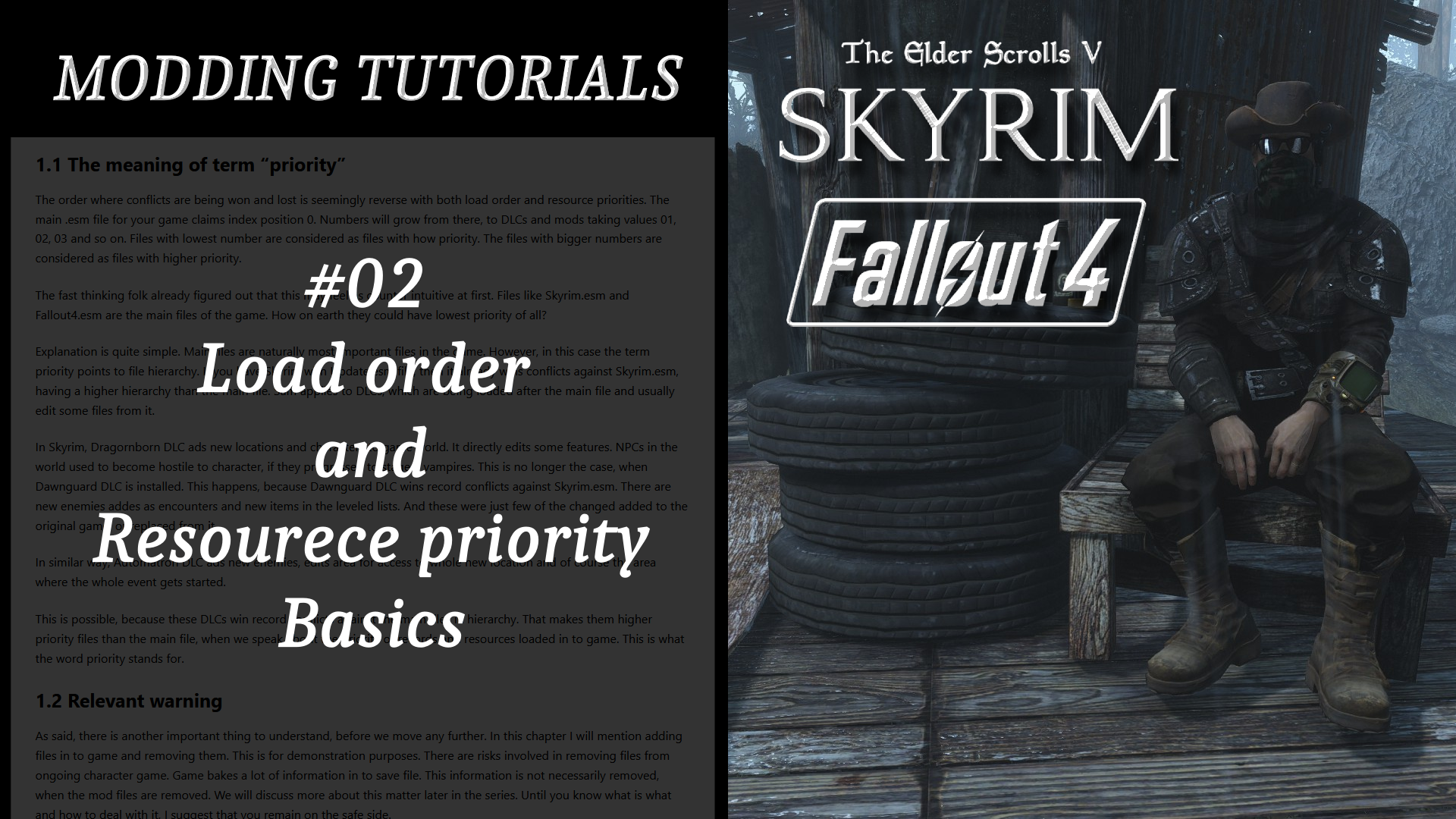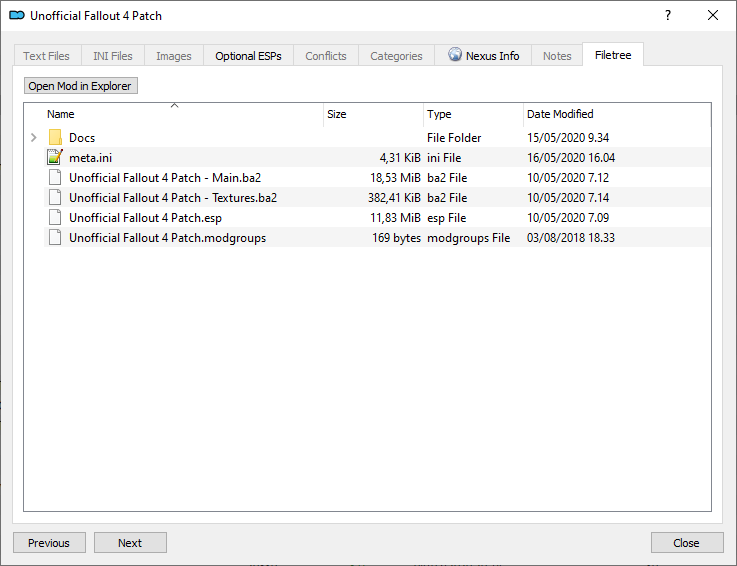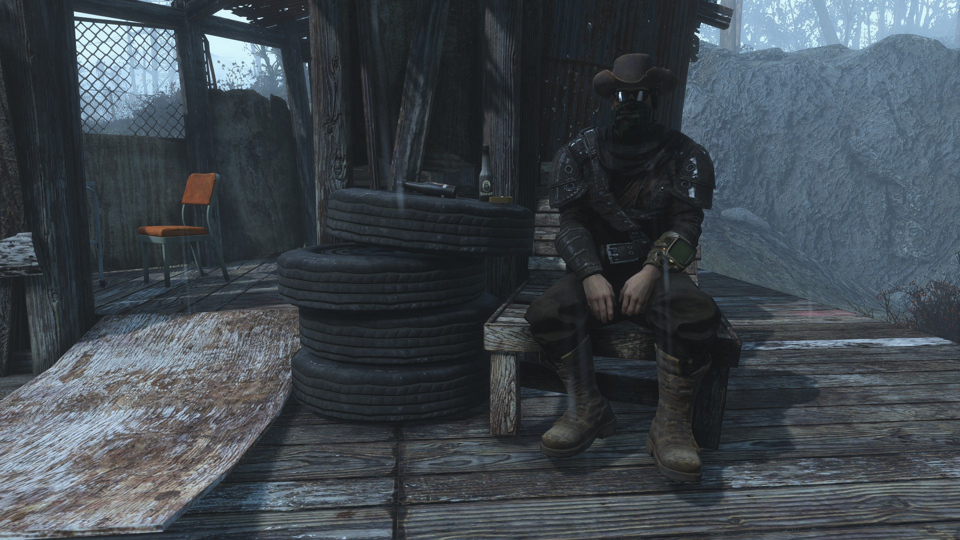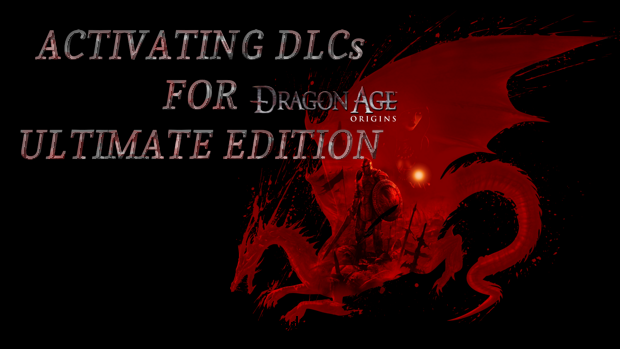
Modding tutorials 2 – Load order and Resource priority basics
Table of Contents
In this article we will take a look at basics of load order and resource priorities. These are are the factors that determine how your modded game looks and how it behaves.
1. Explaining the terms
Terms load order and resource priorities may sound weird and maybe even slightly taunting to someone just starting the modding of Bethesda Game Studios Creation Engine games. Don’t worry too much about it. There are plenty of horror stories around the Internet – as usual – and most of them are not to believed.
It is true that more advanced mod authors and players can treat modding to look and feel like a science. However, people just starting to mod their games only really need to grasp the understanding of what they are doing, when installing mods in to their games. This tutorial series was made for new players in mind, so I will proceed explaining the very basics first, which should be enough for you to understand what is going on under the hood.
There are two things that you need to be aware of, before we proceed any further.
1.1 The meaning of term “priority”
The order where conflicts are being won and lost is seemingly reverse with both load order and resource priorities. The main .esm file for your game claims index position 0. Numbers will grow from there, to DLCs and mods taking values 01, 02, 03 and so on. Files with low number are considered as files with low priority. The files with bigger numbers are considered as files with higher priority.
The fast thinking folk already figured out that this may feel as counter intuitive at first. Files like Skyrim.esm and Fallout4.esm are the main files of the game. How on earth they could have lowest priority of all?
Explanation is quite simple. Main files are naturally most important files in the game. However, in this case the term priority points to file hierarchy. If you have Skyrim with Update.esm file, then it already wins conflicts against Skyrim.esm, having a higher hierarchy than the main file. Sam applies to DLCs, which are being loaded after the main file and usually edit some files from it.
In Skyrim, Dragornborn DLC ads new locations and characters to game world. It directly edits some features. NPCs in the world used to become hostile to character, if they progressed to stage 4 vampires. This is no longer the case, when Dawnguard DLC is installed. This happens, because Dawnguard DLC wins record conflicts against Skyrim.esm. There are new enemies added as encounters and new items in the leveled lists. And these were just few of the changed added to the original game, or replaced from it.
In similar way, Automatron DLC ads new enemies, edits area for access to whole new location and of course the area where the whole event gets started.
This is possible, because these DLCs win record conflicts against the main files in hierarchy. That makes them higher priority files than the main file, when we speak about the priority of records and resources loaded in to game. This is what the word priority stands for.
1.2 Relevant warning
As said, there is another important thing to understand, before we move any further. In this chapter I will mention adding files in to game and removing them. This is for demonstration purposes. There are risks involved in removing files from ongoing character game. Game bakes a lot of information in to save file. This information is not necessarily removed, when the mod files are removed. We will discuss more about this matter later in the series. Until you know what is what and how to deal with it, I suggest that you remain on the safe side.
Do not remove mods from ongoing game.
Test new mods properly first. If you choose to uninstall them, then load a save file from the time before you installed the mod you tested.
2. What is load order?
In previous chapter I mentioned word plugin. These are those .esm, .esp and .esl files that come with most mods.
Plugins include records. These records are also known as forms. The load order is the order, where records in plugins win and loose conflicts against each other, when they are loaded in to game.
Records in plugins can win conflicts against official files, causing some values from the game. I will give an example. In Fallout 4 there is an item called Welding Goggles, which grants +1 bonus to player or NPC Perception stat. A simple mod would be a plugin, where this value is changed at +2.
In this case the mod authors would copy relevant item records from Fallout4.esm to a new plugin, and then change the value from +1 to +2 for the new plugin. When this plugin is loaded in to your game as part of your load order it will overwrite records for Welding Goggles from Fallout4.esm. Game will read this information as it would be part of the original and Welding Goggles will have Perception bonus +2, instead of +1 for as long as the plugin remains in your load order.
That is the most basic form of load order. A simple plugin changing a simple value from the main file.
2.1 Not entirely that simple
I presented a very optimal situation above, in a form of a simple plugin. Things can get far more complex than that, when working with load orders. There might be multiply plugins conflicting with each other. When files loaded last will win conflicts against files loaded first, your load order determines which records will come in to game.
Additional problem is that most mods wanting to edit just one thing will have to copy over plenty of other records. If you are editing something for interior location, you are bringing several records from edited cells over with your new plugin file. These records might be just lighting records, which could conflict with interior light mod you are using. The effect may be minimal, or it may be obvious.
The ground rule remains When ever records conflict, then one loaded last will win the conflict and take effect in your game.

3. What are resource priorities?
In previous chapter of this series we talked about two different types of sharing resource files. They can be shared as archived files, or loose files.
The ground rule for resources is the same with load order. Conflicting resources loaded last will win the conflict and take effect in the game. However, with resources the matter is slightly more complex than that.
3.1 Archived resources
BSA is the older Bethesda Software Archive type, which is used by Skyrim. BA2 is the newer Bethesda Software Archive type, which is used by Fallout 4. There is no real difference between them, if you inspect them from mod user’s point of view.
Both archive types work in similar manner. They store resource files for the game. These archive files require respective plugin to load them (esm, esp or esl) and there can be several archives being loaded at once by a single plugin.
3.2 So what are resources?
Resource files are the files that build the world. They include creative work like textures, meshes, voice files and music.
In addition creative work, these archives can also include scripts. This is important for mod users to note, because scripts play a big part of game stability. If there are any script conflicts that need to be solved, then things can get problematic. Mod might have old script or scripting utility version included in it, ending up winning script conflicts against files having the up to date information. This may break a big part of modded game. The order of such files is important.
3.2.1 How does resource priorities work for archived files?
Bsa and ba2 files are loaded in the same time than their respective plugins are. If the plugin has lower priority than another mod that has conflicting resource files in it, then it will lose resource conflicts as well as possible record priority conflicts.
This may have an effect on how tools and forum instructions are treating some files. You might not see any direct conflict between them by inspecting just records, but archives themselves might have a conflicts. Mod download description pages often marks potential resource conflicts with other files, or files that might require patches with the mod.

Resource conflicts for archived files are tricky to spot by inexperienced user. This is why new players are recommended to use tools like Load Order Optimization Tool LOOT and read what mod author says about possible conflicts. Also keep in mind that up to date mod managers Vortex and Mod Organizer 2 are already using LOOT API. We will discuss about LOOT and both managers in more detail later in this series.
3.2.2 Resource priorities and loose files
Loose resource files include same files as archived files. However, there is a twist that can be beneficial when used correctly, or cause a big mess in your game, if used in wrong situation.
Loose files will win all conflicts against archived files!
What ever your load order is for your resource archives to load, if there are any loose file resources sharing the same file names with them, then loose files will always win conflicts against them.
Another thing to consider is that if loose files would be installed in to your Data folder, then conflicting files would directly over write each other. Many resource files and especially replacement files share the same filename. You can not have files with same filename in the same folder. Renaming the file would simply prevent it from working.
This is also one of the reasons why modern mod managers do not actually install any files in to Data folder. They use either hard links or virtual Data folder instead. That makes it far easier and safer for you to manage your mod files.

Loose files tend to slow down loading times of the game. They are not currently regarded as preferred files, unless there is a specific reason to use them. In some cases there are valid reasons to use loose files. Otherwise it would be best to see if mod author is sharing archived versions of their work. This is especially true, if you are dealing with huge graphical enhancement mods. There is no real reason to install them as loose files, when esl-files are adding thousands of new index positions and releasing plenty of hard plugin index slots for more advanced uses.
4. Final words of this chapter
We have reached the end of this article. I hope you have found it easy to follow and understand.
Feel free to leave comments and critique to comments below. This series will continue for some time. I am willing to write replies and possibly even create additional videos to clear things further.
Keep in mind though that this specific series is about basics of modding the game. It is meant for people who are just staring, or have already gone through their mod it till it breaks part and now want to try again with better understanding.
The next part of this series will talk about leveled lists. I will explain what they are and how they work in your game. After that we are ready to take a look at modding services, how to install mods from sites and services like Nexus Mods and Bethesda.net. We will continue with file management part after that.
5. Credits
Following people have contributed to this article. List in alphabetical order.
- Avrie – Fixing my typos and suggesting more fitting terms.
6. Article changes
- 20.06.2020: Added Credits.
- 20.06.2020: Fixed some typos.



